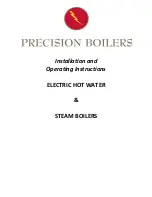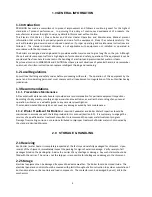
8
□
With an ohmmeter, check the resistance between the phases on the load side of the contactors. Each
should read the same and approximately what is shown on the wiring diagram.
□
Check the electrical panels for loose material, dust and / or moisture. Thoroughly vacuum the panels if dust
or foreign materials have accumulated there
.
If there has been severe exposure to dust, the contactors should
be disassembled and cleaned. Dust in the contactors will cause contractor chattering and eventual destruction
of the contacts
.
All components should be clean and free of dust, moisture, and foreign matter
!
□
Verify that field-installed control and load connections have been properly completed
.
□
Check the tightness of all control circuit connections
.
4.4 Heating Element
CAUTION:
Moisture in the elements may result in damage to the elements.
NOTE:
There is a possibility that during shipment or storage prior to operation, the elements may accumulate
moisture. The moisture will turn to steam when the elements are turned on and may rupture the element
casing.
4.4.1 How To Check Elements for Moisture
Take a reading with a megger between the contactor terminals (load side) to ground for each contactor.
Moisture is present if the reading is less than 1 megohm for standard 3-phase connection.
4.4.2 Removal of Moisture in Element (method #1)
Remove the fuses going to that contactor. The fuses should be removed so that, during the first day of
operation, the affected element will not be energized allowing the hot water to drive the moisture out at a
controlled rate
.
4.4.3 Removal of Moisture in Element (method #2)
An alternate heating method is to direct a heat lamp at the suspect element, or remove the element, bake it in a
200°F oven for 8 hours, then reinstall and rewire.
4.4.4
After completion of either of the above methods for moisture removal, re-check the element with a
megger. When the reading indicates an acceptable level, the element may be put in operation by replacing the
fuses
.
4.4.5
Replace all Element Access Panel(s) and close electrical / control panel
doors.
4.5
Inspection Power/Voltage
Verify the boiler’s ON/OFF switch is in the “OFF” position. Close the boiler main switch, switch the control
switch to “ON” and then:
Check the phase-to-phase voltage at the main terminals in the boiler electrical panel. The phase-to-
phase voltage between any two of the phases
must not exceed
the boiler nameplate voltage.
Check the voltage at the boiler control circuit fuse. It should be between 105 volts and 125 volts.
Open the boiler main power switch.
If all of the above prove satisfactory, proceed with “Startup Instructions”. Replace all covers and close all doors.
5.0 STARTUP INSTRUCTIONS
5.1 Control Settings
5.1.1 Controller
(See Parts List for Part No. and Type)
5.1.1.1
The controller is the pressure or temperature sensing device which controls the operation of the
contactors directly or indirectly via the step control
.
5.1.1.2
Set the Controller for the desired Outlet Water Temperature (or Steam Pressure
).
































